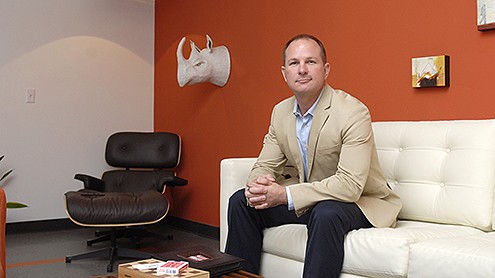Nip, tuck and click: Etna’s regulatory know-how is key to success with clinics

Etna founder and CEO Ryan Miller. The San Luis Obispo-based firm found its niche by providing digital marketing services to the medical and aesthetics industries, sectors that have strict and complicated rules about how they can market and communicate to clients. (Stephen Nellis photo)
With the latest in advanced medical technology and techniques, today’s aesthetic surgeons can make just about anyone beautiful. But who makes those clinics beautiful online?
San Luis Obispo-based Etna Interactive has been providing digital medical marketing for a decade to everything from single-physician practices to regional clinic networks to medical device makers such as Allergan. And over the past year, business has been booming, doubling Etna’s headcount to about 70 with plans to have as many as 100 employees by the end of this year.
Etna’s staff members have become experts in helping guide doctors and device makers through the complicated maze of regulations that govern how they communicate with patients and market their products and services. The rules vary from country to country and even state to state. In Australia, for example, pharmaceutical brand names can’t be mentioned, and there are bans in about half of Canada on before-and-after photos.
“We’ve cultivated how to work through those guidelines,” said Etna founder and CEO Ryan Miller. “We often get requests from clients to do something illegal — not because they want to break the law, but because they don’t know the regulations. Their focus is on caring for patients.”
And the rules aren’t poised to get any simpler. Etna closely monitors the regulatory environment — this year, for example, government officials will be cracking down on elements of the Health Insurance Portability and Accountability Act, better known as HIPAA, that previously weren’t enforced rigorously.
“This year is going to be a mess for people,” Miller said. “It’s really dicey waters for the average practice. You’re going to find multiple HIPAA violations. It’s not that they don’t want to follow the regulations. It’s that the regulations are so poorly articulated.”
Take, for example, something as simple as a contact form on a website. Most marketers view those leads as nearly as good as gold: The potential client knows who you are, found your website, and is contacting you about services. But Etna has to ensure that doctors have a secure, HIPAA-compliant way to gather those leads and follow up on them.
“According to the letter of the law, as soon as a patient reaches out to a clinic for medical advice, it creates an implied doctor-patient relationship,” Miller said.
Miller started Etna after working for a Santa Barbara-based network of clinics that wanted to relocate the headquarters to Atlanta. (“They have humidity and they have huge bugs there,” Miller said.) He said that coming from working as an in-house marketer rather than an agency left him with a different mindset about how to work with medical clients. At nearly every level, the medical business is a people business, where relationships count.
“I was an employee, a partner in their success,” Miller said. “We focus on steering our clients away from things that waste their time and money. Rather than burning and churning clients, I wanted to focus on building clients we could keep forever.”
At the same time, doctors have an inherent disposition to be curious about the efficacy of their marketing dollars, which Miller said dovetails well with digital channels of reaching clients. “I’m an engineer by training and a marketer by trade. We focus on demonstrable results and data driven decisions,” he said.
While there are still a few traditional marketing methods that work well for aesthetics clinics — direct mail has again become popular because consumers are deluged with digital content, and billboards are have become a favorite — Miller said that digital marketing is “centerpiece” of most clinics’ overall marketing budget. But Etna goes beyond marketing services. Most of its account executives also serve as a sort of business consultant as well, helping doctors harmonize the operation of their clinics with their branding. Miller said that’s absolutely necessary because the patient experience in the office becomes part of the brand when patients go online to post reviews.
“Today it’s moved from a financial discussion to a conversation about the preservation of reputation,” Miller said. “You’ll see the best doctors in the world get bad reviews because they have old magazines in the waiting room and patients have to wait a long time for an appointment.”
Etna is currently experiencing some growing pains — Miller is looking for a 25,000-square-foot space to house all those people — but its approach has been to hold on to employees the way it does clients.
“We’ve averaged 32 percent growth over 10 years,” Miller said. “What I’m most proud of is that we’ve got the right work-life balance going on. We pay our staff high enough wages that they can support families. We sacrifice a little bit of margin, but we earn the right to hang on to them longer.”









